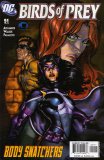Stripping Down #4
 Birds Of Prey #91 (DC Comics)
Birds Of Prey #91 (DC Comics)“Donor” by Jim Alexander, Brad Walker & Jimmy Palmiotti
My knowledge of Birds Of Prey – an all-female super-team comprising Oracle, Huntress, Black Canary and Lady Blackhawk – is limited to their brief appearances in Panini UK’s Batman Legends reprint title. So, this standalone tale by Jim Alexander (standing in for series writer Gail Simone) is perhaps the ideal test of the ‘fill-in’ issue. All too often, my experience of ‘fill-ins’ have not been that they provide a good ‘jumping on’ point or self-contained story. Rather, they’ve often proved to be the dumping ground for filler, inventory material either completely out of continuity or so dated that they have to be presented as ‘flashback’ tales. Let me just say that my ignorance of Birds Of Prey, or apprehension regarding the ‘fill-in’ were quickly and positively addressed by Jim Alexander’s story, although die-hard fans have been apparently more critical. The narrative focuses on crooked casino owner Joseph Bull, or more specifically his nephew Tod, the eponymous donor, who arrives in Metropolis for an operation that will save his uncle’s life. Inevitably, elements of the city’s police and criminal population are keen to see that Bull does not get a new lease of life. Birds of Prey, directed by wheelchair tactician Oracle from their hidden base, seek to ensure that Tod has the operation. Alexander constructs a layered story that deliberately addresses some questions, but leaves others unanswered. Huntress reveals a history with Bull that threatens to impair her judgement in the field. Meanwhile, Oracle’s own motives for wishing Bull to survive do not become apparent to Huntress until much later (and, judging by some of the online criticisms, seem to have bypassed some US readers altogether). Admittedly, the story is ostensibly about Oracle, Huntress and Tod (critics again take note: the clue was on the cover), so I don’t feel that I really gained an insight into the other team members or their adversaries, two members of The Royal Flush Gang. However, it achieves the basic necessity of showcasing the Birds Of Prey as a team, without overcrowding the story with too many narrative viewpoints. Alexander’s dialogue is effective, particularly during Oracle’s exchanges with Huntress and, later, Joseph Bull himself. Brad Walker is an artist I’ve not heard of, but he does a good job in realising the script. The visuals are sharpened considerably by ink work from Jimmy Palmiotti that avoids overpowering Walker’s pencils. The final panel featuring Huntress is oddly reminiscent of Alan Davis and Paul Neary. Like I said, I’ve never read Birds Of Prey so can’t comment on whether the writing is superior or inferior to Gail Simone’s current run. However, taken (as it’s presented) as a standalone issue, I thought it was accessible and, more importantly, a solid story with pleasing art. In short, ‘fill-in’ but not filler.
DC Comics website
 Whoa Nellie! (Fantagraphics Books)
Whoa Nellie! (Fantagraphics Books)by Jaime Hernandez
The first – and last – Jaime Hernandez works I picked up were the early British collections of his Love & Rockets series nearly twenty years ago (!). Considering not only how much I loved reading (and rereading) these stories, but also Hernandez’s influence on my own comic strips, by rights my bookcase should be bulging under the weight of his subsequent collections. It’s not, but I’ll leave the point there before I forget that this is supposed to be a review… Whoa Nellie! is a tale about female wrestlers, the basic storyline focusing on childhood friends Xo and Gina as they compete for the Women’s Texas Championship title. As might be expected from Hernandez, the narrative is more about competitiveness, how professional aspirations can compromise personal values and, unsurprisingly, the value of relationships. Hernandez excels at this type of storytelling: the joy of his deceptively simple writing and art is it’s universal appeal; the narrative is arguably analogous to any number of personal experiences. Hernandez’s economy of art contains an energy and expressiveness that puts many artists working in the more lucrative mainstream to shame. And boy, does Hernandez champion the female form! There’s a memorable sequence, when veteran wrestling duo The Birmingham Lady Bashers pound Xo and Gina into submission, which contains an inherent beauty and grace that is simply breathtaking. This book apparently collects a three-issue mini-series from 1996, and was apparently Jaime Hernandez first post-Love And Rockets work. This edition boasts the addition of six new pages, though there are no obvious ‘breaks’ in the narrative. In fact, given the choice, I would probably still enjoy Whoa Nellie! more as a single, continuous piece. Experiencing Jaime Hernandez is like meeting a friend after years apart and immediately clicking, with none of the awkwardness of absence. My only hope is that I don’t leave it as long between visits next time.
Fantagraphics website
 The Mighty World Of Marvel (volume 3) #44 (Panini UK)
The Mighty World Of Marvel (volume 3) #44 (Panini UK)“Master Of The Ring” by Robert Kirkman & Scott Kolins (Marvel Team-Up (v3) #7)
“Once More, The End Of The World…” by Kurt Busiek & Erik Larsen (The Defenders (v2) #1)
“Why Won’t They Believe Me?” by Stan Lee & Steve Ditko (Amazing Adult Fantasy #7)
To put my review in context, I have to admit to an unconditional love for MWOM. It’s partly the nostalgic in me: as a self-confessed Marvel UK obsessive, the original, 1970s MWOM introduced me to the adventures of the Hulk, the Fantastic Four and Daredevil; it also spotlighted the diverse likes of Luke Cage, Planet Of The Apes, Sgt. Fury and his Howling Commandos, Captain Marvel, even Godzilla. MWOM volume 2 was a short-lived 1980s series, but mined the best of Marvel’s then-nascent line of mini-series featuring Wolverine, the Vision and Scarlet Witch and, er, the X-Men and the Micronauts. It was also a showcase for home-grown talent, most notably Alan Moore and Alan Davis’ groundbreaking Captain Britain series. The latest incarnation of MWOM was launched in the wake of the Daredevil and Hulk’s cinematic outings, and largely remained a trawl through the 1960s Marvel archives for it's first couple of years. MWOM's relatively recent relaunch as a broader anthology - both in terms of characters and chronology – has been a much needed shot in the arm.
The current lead strip is Marvel Team-Up by the seemingly ubiquitous Robert Kirkman and Scott Kolins. Originally a 1970s vehicle for Spider-Man, the series was restricted by it’s need to premiere new characters or retrieve existing ones from Marvel Comics limbo. Although Spider-Man has still featured heavily in the latest series, there’s a greater degree of flexibility in the format, allowing for sub-plots and continuing storylines. That said, Marvel’s insistence on structuring story arcs to fit into a subsequent six-issue trade paperback collection does mean that themes are sometimes stretched further than necessary, resulting in a loss of pace. Master Of The Ring begins this issue, as long-time Z-lister The Ringmaster comes into possession of a reality altering ring, leading to an explosive encounter with Spider-Man and Moon Knight. In fairness, credit for The Ringmaster’s reinvention as a credible adversary lies with writer Joe Casey, but Robert Kirkman successfully develops that here, particularly in the sequence where The Ringmaster obtains the ring through a typical deception. Kirkman has a good feel for his cast of characters, especially Spider-Man, whose mocking dismissal of his foe’s threat sets up the inevitable volte-face (and great cliffhanger). I don’t always warm to Scott Kolins’ art, facial expressions being a specific weak spot. That said, he does a great job here, with effective layouts and attention to background detail.
Kurt Busiek and Erik Larsen’s unintentionally brief revival of The Defenders debuts in MWOM with a double-sized episode. This is unashamedly backwards-looking, with writing and art that evokes Steve Gerber and Keith Giffen’s respective work on the title in the 1970s. Fun though this approach is, perhaps therein lies the problem. The premise for the revival of Marvel's greatest 'non-team' is plausible and the story itself is an enjoyable romp, both for it’s slew of typically obscure adversaries and the continual bickering between Dr. Strange, the Hulk, Sub-mariner and the Silver Surfer. However, although rewarding for long-time fans of The Defenders (like me), the use of villains like Yandroth, the Toad Men and the Ravagers of Creation – and arguably the constant continuity references – is likely less appealing to new readers. Busiek and Larsen are credited as writers but I’d suspect that the former’s input may not have extended far beyond plot and the aforementioned continuity, as it’s not on a par with his other team titles, particularly The Avengers. I’m not a great fan of Erik Larsen’s art, but his Giffen-esque style, given an additional rough edge by inker Klaus Janson, complements the writing. Criticisms aside, I enjoyed this instalment and hope that The Defenders will be sticking around for a while.
The issue is rounded off by a 1960s sci-fi short by Stan Lee and Steve Ditko. Why Won’t They Believe Me? has, in retrospect, a predictable twist – I vaguely recall a rather more satisfying remake drawn by Gene Colan. However, at five pages, it’s a snappy counter to the more sophisticated and/or protracted plotting of it's companion strips. If you’ve never read MWOM, give it a try. The varied line-up is a major plus: Dan Slott and Juan Bobillo’s brilliant She-Hulk series has regularly featured of late; the aforementioned Gene Colan’s work with Marv Wolfman on the classic Tomb Of Dracula appears in a couple of months. Consistently enjoyable, MWOM is once more Marvel’s flagship title on the UK newsstand.
Panini UK comics website



0 Comments:
Post a Comment
<< Home